Did you know that among all the Crown Jewels of the United Kingdom, St. Edward’s Crown remains the oldest, dating back to the 12th century? The crown alone has gold lined with at least seven types of gemstones, but the entire set has over 23,000 stones, including the largest clear cut diamond ever found. The fact that these gems have lasted centuries is a testament to why real jewelry is very expensive: because with the right care and maintenance, it can withstand the wear and tear of time and be passed down generations.

Source: Washington Post
If you’re thinking about buying jewelry you can eventually pass down, you need to think about what you’re paying for and where you’re buying it. In the jewelry industry, you get what you pay for, and if you buy cheap jewelry, don’t expect that the gems would be real or it could withstand the wear and tear for more than a few years.
At the same time, though, be careful where or who you’re buying jewelry from. Just because someone is offering to sell jewelry to you at a high price does not mean it is real and worth the value. To be safe, buy your jewelry from well-known jewelers and Jewel stores. Stores such as Cartier, Harry Winston, and Tiffany can guarantee their jewelry’s authenticity. But if you have to buy outside these known brands, here’s how you can easily check the jewelry’s authenticity.

Source: MINING.com
Diamonds
At approximately $3,000 a carat, you don’t want to be fooled into buying a fake diamond for a real diamond’s selling price. Looking at a diamond ring from afar, it is difficult to differentiate a genuine diamond ring from cubic zirconia or other similar looking gemstones. You can find affordable diamond testers online, but this may be a bit confusing and requires a bit of research into how diamonds are classified.
If you don’t want to buy the tester, there are simple ways to check its authenticity. For one, you can simply breathe a puff of air on the diamond. Diamonds are good heat conductors and can disperse heat quickly. If the fog from your breath disappears immediately, it is real. If it takes a few seconds to disappear, it does not conduct heat well and is a diamond.
Because diamonds are stronger than cubic zirconia or any other fake diamond, you can test its strength. While wearing fireproof gloves, hold the diamond with a pair pliers over a heat source like a lighter or a stove. Let it heat for 40 seconds before dropping the diamond into a glass of cold water. If it breaks, the diamond is fake. Weak materials like cubic zirconia cannot withstand the rapid expansion and contraction when you put it under extremely hot temperature and then place it in cold temperature. Because diamonds are strong, it will resist the heat test and remain unchanged.

Source: Diamond Exchange Dallas
However, you might run into a problem if the seller doesn’t want you to perform these checks, as they can affect the quality of the product. If the first two methods are unavailable, simply shine a light over the diamond. Diamonds sparkle because they are good at refracting light. A diamond’s brilliance looks grayish-white, but cubic zirconia looks like there is a rainbow trapped inside. It’s why photography experts at Paperboatcreative.com are careful with diamond jewelry to emphasize the brilliance in order to prove its authenticity. Otherwise, simply bring a newspaper and place the diamond over a few words. If you can roughly see the letter under the diamond, it is fake. A real diamond would refract the image underneath it.
